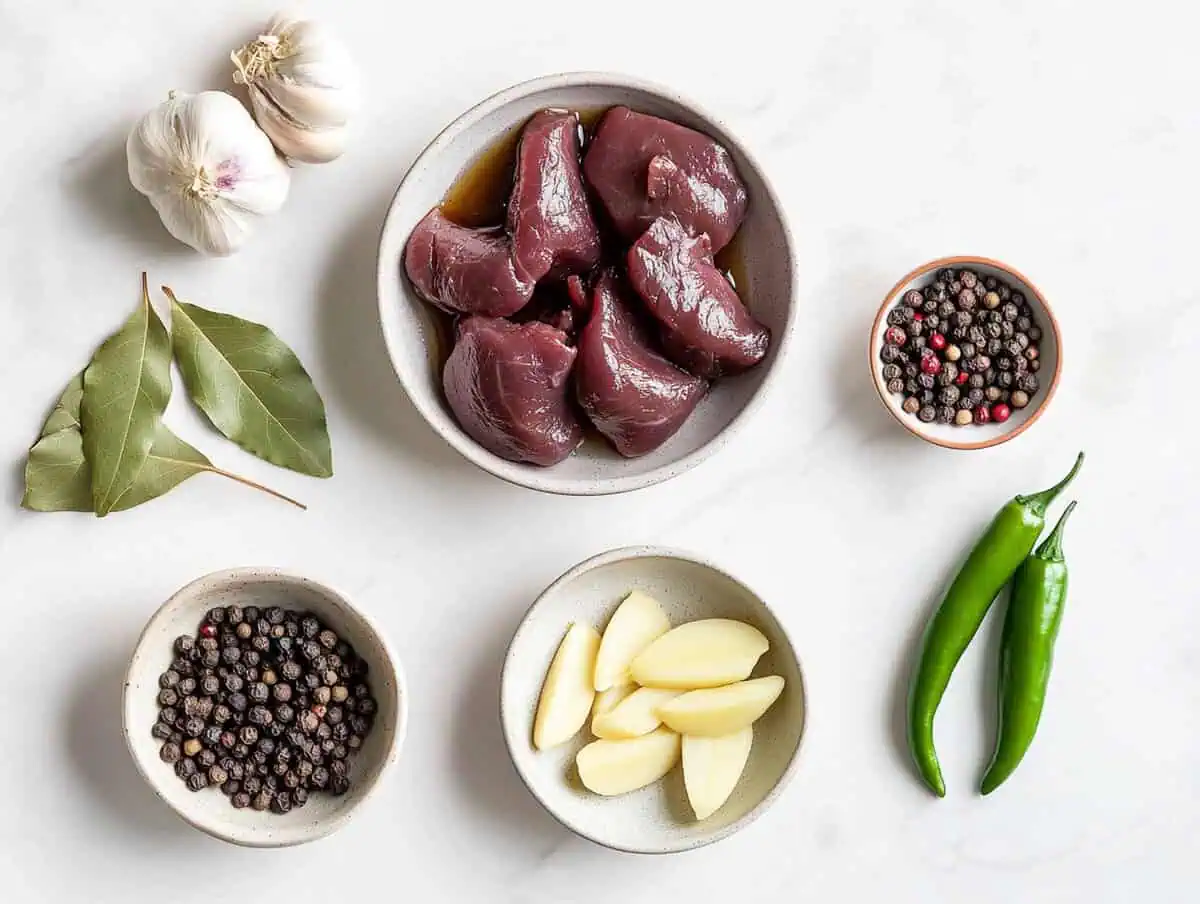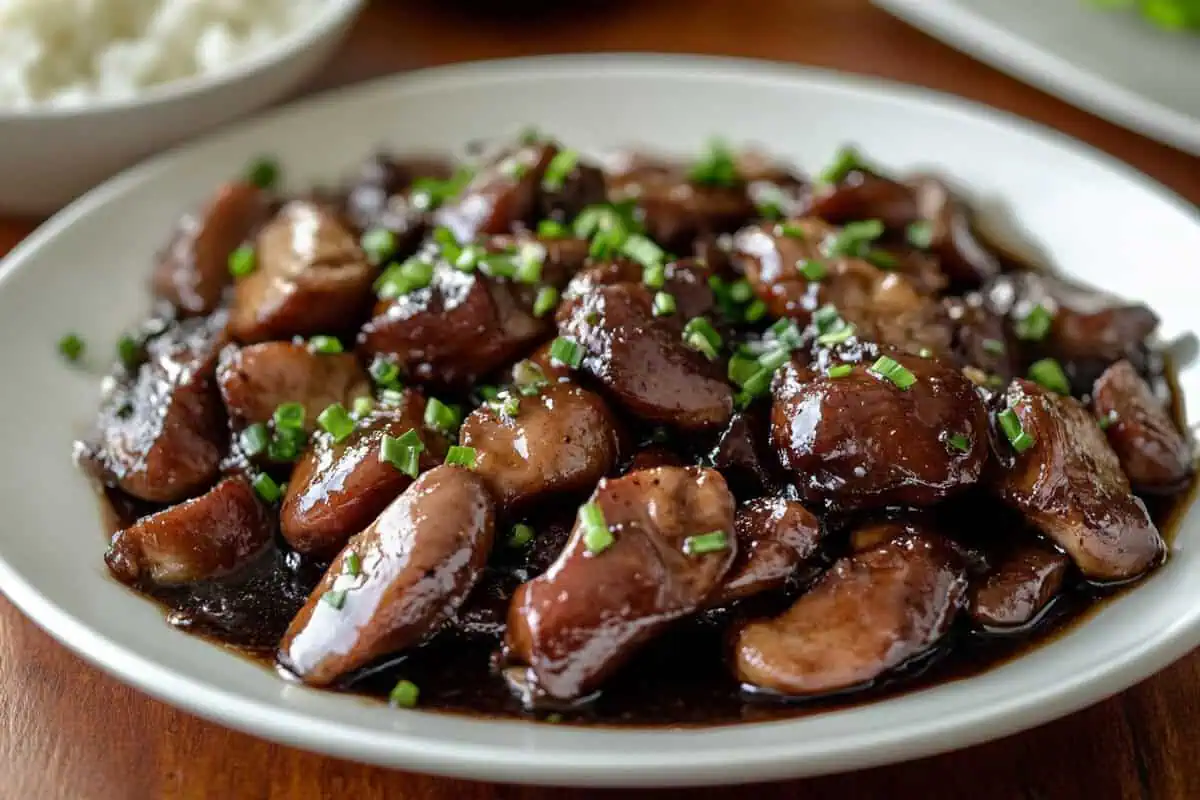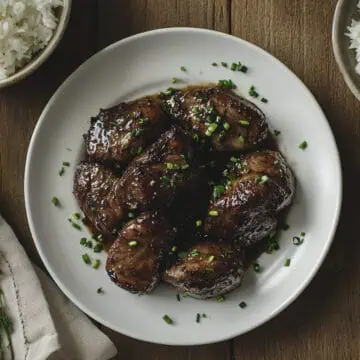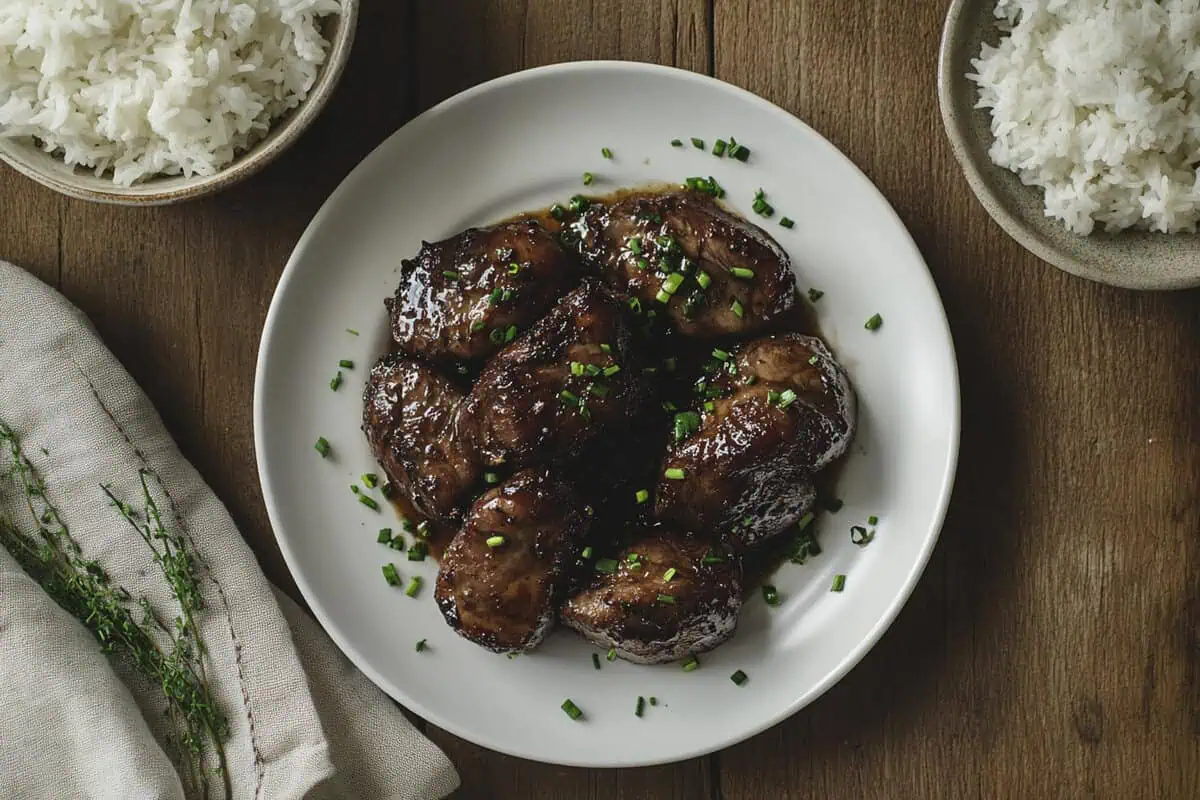I am going to teach you how to cook Chicken Liver Adobo. This recipe has been my go-to for years when I want something flavorful but budget-friendly. The chicken livers soak up that perfect balance of soy sauce and vinegar that makes Filipino adobo so crave-worthy, while the crispy edges and tender insides create an amazing texture contrast.
I've perfected this recipe through countless family dinners, and it's now one of our absolute favorites. It's surprisingly easy to make, incredibly nutritious, and brings all the classic adobo flavors you love but with a rich, unique twist.
What Is Chicken Liver Adobo?
Adobong Atay ng Manok is a variation of the famous Filipino adobo cooking method, using chicken livers instead of the more common pork or chicken meat. This dish follows the same principle of cooking protein in a mixture of vinegar, soy sauce, and aromatics, but with the unique iron-rich flavor profile that only chicken livers can provide.
It's a beloved comfort food in Filipino homes and a perfect introduction to organ meats for those looking to diversify their protein sources.
Jump to:
Why You'll Love This Recipe
Craving a delicious Filipino dish that won't break the bank? This Chicken Liver Adobo delivers all the signature savory-tangy flavors of traditional adobo with the rich, buttery texture of perfectly seared chicken livers.
Not only is this dish incredibly economical, but it's also packed with nutrients, making it a smart addition to your meal rotation.
The combination of aromatic spices, crispy edges, and that distinctive adobo sauce creates a memorable dish that's perfect for both everyday meals and special occasions.
Ingredients
I've carefully selected these ingredients to create the perfect balance of flavors and textures. The chicken liver provides a rich, creamy base while being incredibly nutritious. The classic adobo mix of soy sauce and vinegar creates that signature tangy-savory taste, while bay leaves and peppercorns add depth.
Garlic, ginger, and onions work together to counter the natural metallic taste of liver and add aromatic complexity. The green chilis are optional but add a gentle heat that cuts through the richness for those who enjoy a slight kick.

- 2 pounds chicken liver
- ½ cup soy sauce
- ½ cup vinegar
- 1 cup water
- 3 pieces bay leaves
- 1 teaspoon peppercorns
- 3 tablespoons oil
- 6-8 cloves garlic, cut into thin slivers
- 1 thumb-sized piece ginger, julienned
- 1 medium yellow onion, chopped
- 2 pieces long green chilis, chopped (optional)
Equipment
- Large skillet or wok
- Medium pot
- Colander or fine-mesh sieve
- Sharp knife and cutting board
- Measuring cups and spoons
- Tongs or slotted spoon
- Serving platter

How To Make
- Prepare the liver: Soak the chicken livers in cold water for 5 minutes. Drain water and rinse with cold water. Set aside in a colander to remove excess moisture.
- Make the adobo base: In a pot, combine soy sauce, vinegar, water, bay leaves, and peppercorns. Bring to a simmer over medium heat. Let it simmer for 3-5 minutes to mellow the acidity of the vinegar.
- Cook the liver: Turn heat to low, and add liver one by one. Cook just until the liver turns opaque and no longer pink and becomes firm, about 5 minutes. Remove the livers from the sauce and continue to simmer until the sauce is reduced.
- Prepare aromatics: In a skillet over medium heat, add oil then the garlic slivers. Stir once the oil becomes hot to prevent burning. Lower heat and fry the garlic just until golden and crispy, then remove from oil and set aside.
- Build flavors: Cook the ginger in the same oil for several seconds until lightly browned. Add the onions and cook until soft and translucent.
- Finish the dish: Add the chicken livers and cook until sides are nicely browned. Pour the reduced sauce over and simmer until it thickens. You can also cook it longer so that the sauce is almost completely reduced.
- Final touch: Toss in the green chilis (if using) and then turn off the heat.
- Serve: Transfer to a serving dish and top with the toasted garlic slivers.

Tips from Lola's Kitchen
- Perfect liver selection: Choose fresh chicken livers with a deep red, almost mahogany color. They should be moist but never slimy.
- Soak properly: Soaking in cold water helps remove impurities and blood, resulting in a cleaner flavor and better texture.
- Milk soak option: For those sensitive to liver's metallic taste, try soaking the livers in milk for 30 minutes before cooking, then rinse well.
- Don't rush the vinegar: When simmering the vinegar mixture, avoid stirring initially to allow the acid to mellow properly.
- Quick cooking is key: Chicken livers cook extremely fast! Watch them carefully and remove from heat as soon as they're no longer pink inside.
- Crispy exterior, tender interior: Use a large enough pan to give the livers space to sear properly without overcrowding.
- Garlic control: When frying garlic slivers, lower the heat immediately once the oil is hot to prevent burning.
Substitutions
- Vinegar varieties: While white or cane vinegar is traditional, you can experiment with apple cider vinegar for a slightly different flavor profile.
- Soy sauce alternatives: Low-sodium soy sauce works well for those watching their salt intake. Coconut aminos can be used for a soy-free version.
- Spice options: If you don't have whole peppercorns, substitute with ½ teaspoon freshly ground black pepper.
- Add-ins: Some families add chicken hearts along with the livers, or include hard-boiled eggs for extra richness.
- Vegetable additions: For a more complete one-pot meal, try adding diced potatoes or bell peppers during the final cooking stage.
Troubleshooting
- Tough, rubbery livers: This happens when livers are overcooked. Remember they only need about 5 minutes initially and a brief second cooking when returned to the sauce.
- Too acidic: If your adobo tastes too sour, add ½ teaspoon of sugar to balance the flavors.
- Metallic aftertaste: If the liver taste is too strong, next time soak in milk rather than water, and make sure to use plenty of aromatics like ginger and onion.
- Watery sauce: If your sauce is too thin, simmer longer uncovered until it reaches your desired consistency.
- Burst livers: If the livers burst during cooking, your heat was likely too high. Use medium-low heat and avoid overcrowding the pan.
Storage & Reheating
- Refrigeration: Store leftovers in an airtight container in the refrigerator for up to 3 days.
- Microwave reheating: Reheat in 30-second intervals to prevent the livers from bursting or becoming tough.
- Stovetop reheating: For best texture, reheat gently in a covered pan over low heat with a tablespoon of water added.
- Flavor development: Like many adobo dishes, the flavors often improve after a day in the refrigerator as the ingredients meld together.

FAQ
Is chicken liver healthy?
Absolutely! Chicken liver is considered a nutritional powerhouse. It's rich in iron, folate, and vitamins A and B12. It provides high-quality protein with fewer calories and fat than most muscle meats. Despite misconceptions, liver doesn't store toxins and is safe to eat when properly cooked.
Can I make this dish less salty?
Yes, you can reduce the amount of soy sauce and increase the water slightly. Using low-sodium soy sauce is another good option.
How do I know when chicken livers are perfectly cooked?
Perfectly cooked chicken livers should be slightly pink in the center but not raw. They should be firm to the touch but still tender when cut into. Overcooking makes them grainy and tough.
Can I add other meats to this adobo?
Certainly! Some cooks combine chicken livers with chicken gizzards or hearts for variety. You could also add a small amount of pork belly for additional richness.
What's the best way to serve chicken liver adobo?
The traditional way is with steaming hot white rice or garlic rice. It also makes an excellent pulutan (appetizer) for social gatherings or can be served with crusty bread to soak up the delicious sauce.
Related
Looking for other recipes like this? Try these:

Adobong Atay ng Manok (Chicken Liver Adobo)
Ingredients
- 2 pounds chicken liver
- ½ cup soy sauce
- ½ cup vinegar
- 1 cup water
- 3 pieces bay leaves
- 1 teaspoon peppercorns
- 3 tablespoons oil
- 6-8 cloves garlic cut into thin slivers
- 1 thumb-sized piece ginger julienned
- 1 medium yellow onion chopped
- 2 pieces long green chilis chopped (optional)
Instructions
- Prepare the liver: Soak the chicken livers in cold water for 5 minutes. Drain water and rinse with cold water. Set aside in a colander to remove excess moisture.
- Make the adobo base: In a pot, combine soy sauce, vinegar, water, bay leaves, and peppercorns. Bring to a simmer over medium heat. Let it simmer for 3-5 minutes to mellow the acidity of the vinegar.
- Cook the liver: Turn heat to low, and add liver one by one. Cook just until the liver turns opaque and no longer pink and becomes firm, about 5 minutes. Remove the livers from the sauce and continue to simmer until the sauce is reduced.
- Prepare aromatics: In a skillet over medium heat, add oil then the garlic slivers. Stir once the oil becomes hot to prevent burning. Lower heat and fry the garlic just until golden and crispy, then remove from oil and set aside.
- Build flavors: Cook the ginger in the same oil for several seconds until lightly browned. Add the onions and cook until soft and translucent.
- Finish the dish: Add the chicken livers and cook until sides are nicely browned. Pour the reduced sauce over and simmer until it thickens. You can also cook it longer so that the sauce is almost completely reduced.
- Final touch: Toss in the green chilis (if using) and then turn off the heat.
- Serve: Transfer to a serving dish and top with the toasted garlic slivers.
Tips from Lola's Kitchen
- Perfect liver selection: Choose fresh chicken livers with a deep red, almost mahogany color. They should be moist but never slimy.
- Soak properly: Soaking in cold water helps remove impurities and blood, resulting in a cleaner flavor and better texture.
- Milk soak option: For those sensitive to liver's metallic taste, try soaking the livers in milk for 30 minutes before cooking, then rinse well.
- Don't rush the vinegar: When simmering the vinegar mixture, avoid stirring initially to allow the acid to mellow properly.
- Quick cooking is key: Chicken livers cook extremely fast! Watch them carefully and remove from heat as soon as they're no longer pink inside.
- Crispy exterior, tender interior: Use a large enough pan to give the livers space to sear properly without overcrowding.
- Garlic control: When frying garlic slivers, lower the heat immediately once the oil is hot to prevent burning.
The Story Behind Chicken Liver Adobo
The history of Filipino adobo stretches back centuries, with roots in indigenous cooking methods enhanced by Spanish colonial influence. The word "adobo" comes from the Spanish "adobar," meaning to marinate, but Filipinos transformed this concept into their own unique cooking style using vinegar, soy sauce, and spices.
Traditional Filipino cooking has always embraced the "nose-to-tail" philosophy long before it became trendy in modern cuisine. Chicken liver adobo emerged from this waste-not approach to cooking, where resourceful home cooks transformed affordable organ meats into delicious, protein-rich meals for their families. This practical dish became a staple in Filipino households where stretching ingredients without sacrificing flavor was essential.
In many Filipino homes, chicken liver adobo holds a special place as comfort food. It's often prepared for everyday family meals rather than for special occasions or restaurants, which is why many visitors to the Philippines might miss experiencing this delicious variation. The dish represents Filipino culinary ingenuity at its finest – taking humble ingredients and elevating them through perfect balance of sour, savory, and umami flavors.
What makes Filipino adobo truly special is its remarkable preservation properties. The combination of vinegar and salt creates an environment hostile to bacteria, making adobo dishes particularly well-suited for the tropical Philippine climate before refrigeration became common. Chicken liver adobo could be cooked and kept at room temperature for days, with many Filipinos believing the flavor actually improves after sitting overnight as the ingredients meld together.
Today, chicken liver adobo continues to be cherished as both a delicious meal and a connection to Filipino heritage. Modern cooks appreciate it not just for its budget-friendly ingredients but also for its impressive nutritional profile, making this traditional dish perfectly aligned with contemporary interest in nutrient-dense foods.










Comments
No Comments